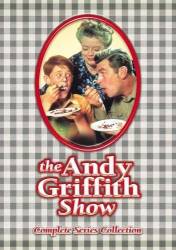Plot hole: When Barney's telling Andy about the poem written on the bank wall, Barney blames Opie and doesn't mention anything about Opie using chalk, but when Opie walks in Andy tells him, "Barney says there's a poem written on the wall of the bank, and that you were standin' along beside it with a piece of chalk in your hand," and then in a few moments Opie explains that some big kids pushed the chalk into his hands. So it's impossible for Andy to have known that chalk was used to write the poem, and not a marker, a pen, or a pencil.

The Andy Griffith Show (1960)
1 plot hole in Andy the Matchmaker - chronological order
Starring: Ron Howard, Don Knotts, Andy Griffith, Frances Bavier

Visible crew/equipment: When Otis tries to escape from Aunt Bee's clutches by hiding in the laundry service van, just as Aunt Bee has the driver open the van's back doors we can see the reflection of the moving boom mic in the left window.
Opie's Group - S8-E9
Andy: Clara, sometimes a parent can't see what he should do, and sometimes it takes a person from the outside to show him. And I'd like to thank you.
Clara: Groovy.
Trivia: In Walker's Drugstore, among all the magazines by the wall there's a TV Guide magazine (from Oct 9, 1954) on the shelf, and on its cover is Lucille Ball the co-owner of Desilu Productions - which produced TAGS, and also filmed at Desilu Studios.
Question: Who was Ralph Henderson?
Join the mailing list
Separate from membership, this is to get updates about mistakes in recent releases. Addresses are not passed on to any third party, and are used solely for direct communication from this site. You can unsubscribe at any time.
Check out the mistake & trivia books, on Kindle and in paperback.




Answer: In S3 x E11 Convicts-at-Large, there is a character named Big Maude Tyler, who is the leader of three female escaped convicts. Andy listens to the radio as the news announcer says that Big Maude's aliases include Clarice or Annabelle Tyler and also one amusingly named Ralph Henderson.
Super Grover ★